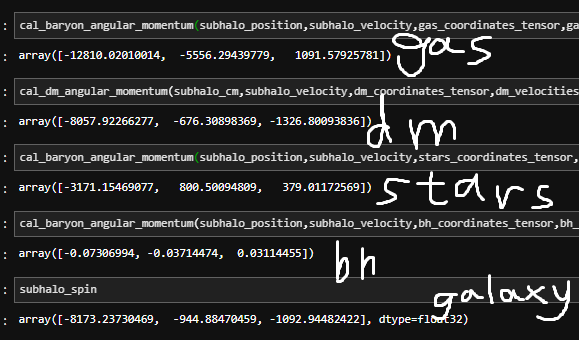I am loading the SubhaloSpin field and find that it differs a lot from my own calculated angular momentum and is closer to the value when only dark matter is considered. I would like to know how the database gives the definition of subhalospin? Should I use my own calculated angular momentum or subhalospin for the spin parameter calculation? The relevant results will be shown in the figure. It shows the angular momentum of gas, dm, stars and black holes, and the subhalo_spin given by the loadSubhalos function.
Thanks for your kindly help!
Dylan Nelson
7 Jun '23
The SubhaloSpin value from the catalog is described as "Total spin per axis, computed for each as the mass weighted sum of the relative coordinate times relative velocity of all member particles/cells."
If you follow that definition exactly, you should be able to reproduce those numbers, exactly. This is a good double-check.
Then, whether you want these values, or you want to calculate something else, is up to you, and depends on your goal.
HI Dylan,
I am calculating the spin parameter of a galaxy in TNG-50-1 defined by Angular momentum properties of haloes and their baryon content in the Illustris simulation. And I need to calculate the angular momentum of a galaxy (i.e subhalo).
I am loading the SubhaloSpin field and find that it differs a lot from my own calculated angular momentum and is closer to the value when only dark matter is considered. I would like to know how the database gives the definition of subhalospin? Should I use my own calculated angular momentum or subhalospin for the spin parameter calculation? The relevant results will be shown in the figure. It shows the angular momentum of gas, dm, stars and black holes, and the subhalo_spin given by the loadSubhalos function.

Thanks for your kindly help!
The
SubhaloSpinvalue from the catalog is described as "Total spin per axis, computed for each as the mass weighted sum of the relative coordinate times relative velocity of all member particles/cells."If you follow that definition exactly, you should be able to reproduce those numbers, exactly. This is a good double-check.
Then, whether you want these values, or you want to calculate something else, is up to you, and depends on your goal.